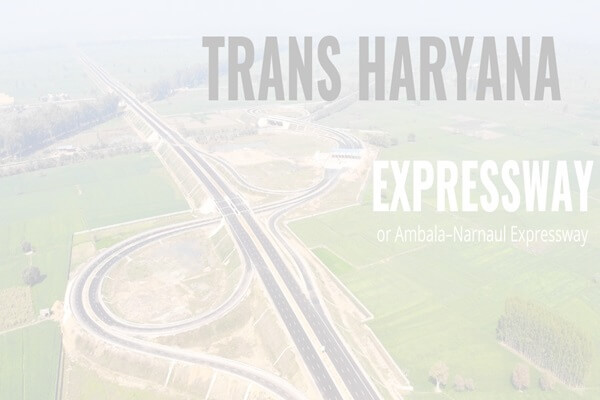Trans Haryana Expressway: 152d highway Route Map
The Trans-Haryana Expressway, also known as the Ambala-Narnaul Expressway or National Highway 152D (NH 152D), stands as a monumental achievement in infrastructure development within the state of Haryana.
Spanning 227 kilometers, this greenfield, access-controlled expressway connects several key districts, enhancing interstate connectivity and facilitating economic growth. In this article, we will delve into the intricacies of the Trans-Haryana Expressway, including its route, districts covered, construction details, economic implications, and future connectivity plans.
Overview of the Trans-Haryana Expressway
The Trans-Haryana Expressway serves as a vital arterial road, linking eight districts of Haryana while providing seamless access to neighboring states. Here are some key details:
- Length: 227 kilometers
- Cost: ₹5,108 crore
- Lanes: 6
- Starting Point: Ghangheri village, Kurukshetra district
- Ending Point: Surana village, Mahendragarh district
- Completion Date: August 1, 2022
This expressway is not only a transport route but also a facilitator of regional development, significantly reducing travel time and enhancing connectivity across the state and beyond.
Route and District Connectivity
Route Details
The expressway connects Ghangheri village in Kurukshetra to Surana village in Mahendragarh district, intersecting major cities and towns along its path. The expressway effectively reduces the distance between Ismailabad and Narnaul, shortening the journey by approximately 35 kilometers compared to the existing route.
Districts Covered
The Trans-Haryana Expressway traverses through eight districts, thereby playing a crucial role in regional connectivity. These districts include:
- Kurukshetra: Known for its historical significance and religious sites, Kurukshetra is the starting point of the expressway.
- Kaithal: A hub for agriculture and trade, Kaithal benefits from enhanced connectivity, promoting local industries.
- Karnal: Known for its agricultural productivity, the expressway aids in the transport of goods and services from Karnal to major markets.
- Jind: This district will see improved access to essential services and commercial hubs, fostering economic growth.
- Rohtak: A significant educational and administrative center, Rohtak stands to gain from the expressway’s connectivity.
- Bhiwani: With a focus on agriculture and industry, Bhiwani will benefit from the faster movement of goods.
- Charkhi Dadri: This district is poised for development, given its strategic location along the expressway.
- Mahendragarh: As the endpoint of the expressway, Mahendragarh will see increased trade and transport opportunities.
Key Intersections
The expressway also connects to several national and state highways, including:
- NH-9
- SH-6
- SH-9
- SH-8
- SH-11
- SH-12
- SH-14
- SH-10
- SH-16A
- SH-20
- SH-24
- SH-26
This connectivity enhances not only regional but also interstate transportation, paving the way for better economic interactions among neighboring states such as Punjab, Rajasthan, and Delhi.
Construction and Development
The Trans-Haryana Expressway was developed by the National Highways Authority of India (NHAI) under the Bharatmala Project, which aims to enhance road infrastructure across India. Construction began in July 2020, and the expressway was completed within two years, opening for traffic on August 1, 2022.
Environmental Considerations
A notable aspect of the construction is its commitment to environmental sustainability. The project included the planting of 136,000 trees along both sides of the expressway. Additionally, several thermal power stations in the region, such as the Tau Devi Lal Thermal Power Plant in Panipat and the Rajiv Gandhi Thermal Power Station in Hisar, will utilize fly ash generated from their operations, further minimizing the environmental impact.
Employment Opportunities
The construction of the expressway not only focused on enhancing connectivity but also created significant employment opportunities. Over three years, approximately 1,500 full-time jobs and 120 ongoing positions for toll plaza staff were generated, contributing to local economic growth.
Economic Implications
The Trans-Haryana Expressway is set to have far-reaching economic implications for the region. By connecting key districts and reducing travel time, it will facilitate the movement of goods and services, thereby enhancing trade and commerce.
Industrial Corridor Development
The area surrounding the expressway is expected to evolve into an industrial corridor, dubbed the Ambala-Kotputli Economic Corridor. This corridor is projected to attract investments in various sectors, including manufacturing, logistics, and services. The presence of improved infrastructure is likely to encourage both domestic and foreign investment, transforming Haryana into a significant industrial hub.
Also read: Atal Progress Way
Real Estate Boom
The impact of the expressway on the real estate sector is also promising. With enhanced connectivity, emerging townships are likely to attract investors and developers, leading to increased demand for residential and commercial properties. The expressway will not only make commuting easier but also increase property values in the surrounding areas.
Job Creation
The anticipated growth in industrial and real estate sectors will contribute to job creation, further improving the economic landscape of Haryana. Increased employment opportunities will enhance the overall quality of life for residents, fostering a vibrant community.
Future Connectivity Plans
The Trans-Haryana Expressway is not only a standalone project but is also part of a broader network aimed at improving transportation across India. Several future connectivity plans are in the pipeline:
Connectivity with Delhi-Mumbai Expressway
NHAI is set to construct an 86.5 km access-controlled highway connecting the Delhi-Mumbai Expressway with the Trans-Haryana Expressway at Paniyala near Narnaul. This connection will significantly reduce congestion on NH 44 and enhance travel times across northern and western India. The anticipated duration for this project is two years, which is expected to further solidify Haryana’s position as a key transportation hub.
Regional Circular Expressway
Plans are also underway to connect the Regional Circular Expressway-3 with the Trans-Haryana Expressway at two key locations: Rajound-Assandh and Mahendragarh-Kanina. This will enhance connectivity for residents in Southern Haryana, particularly benefiting the Mahendragarh district, which stands to become a gateway to North India.
Upgradation of Surrounding Roads
In addition to the expressway, the government is investing in upgrading the Ambala-Saha Road, expanding it to facilitate access to the Saha Growth Centre. Plans to purchase 2,300 acres of land for further development highlight the ongoing commitment to improving infrastructure and economic opportunities in the region.
Conclusion
The Trans-Haryana Expressway represents a significant leap forward in infrastructure development in Haryana. By connecting key districts, enhancing trade and commerce, and paving the way for industrial growth, it is set to transform the economic landscape of the region. As the expressway continues to facilitate better connectivity and promote investment, it is poised to make Haryana one of the top investment destinations in India.
With its promising impact on real estate, job creation, and overall economic development, the Trans-Haryana Expressway stands as a testament to the commitment to improving infrastructure in India. The future looks bright for Haryana, as the benefits of this expressway unfold in the years to come, making it an essential part of the region’s growth narrative.




Post Comment